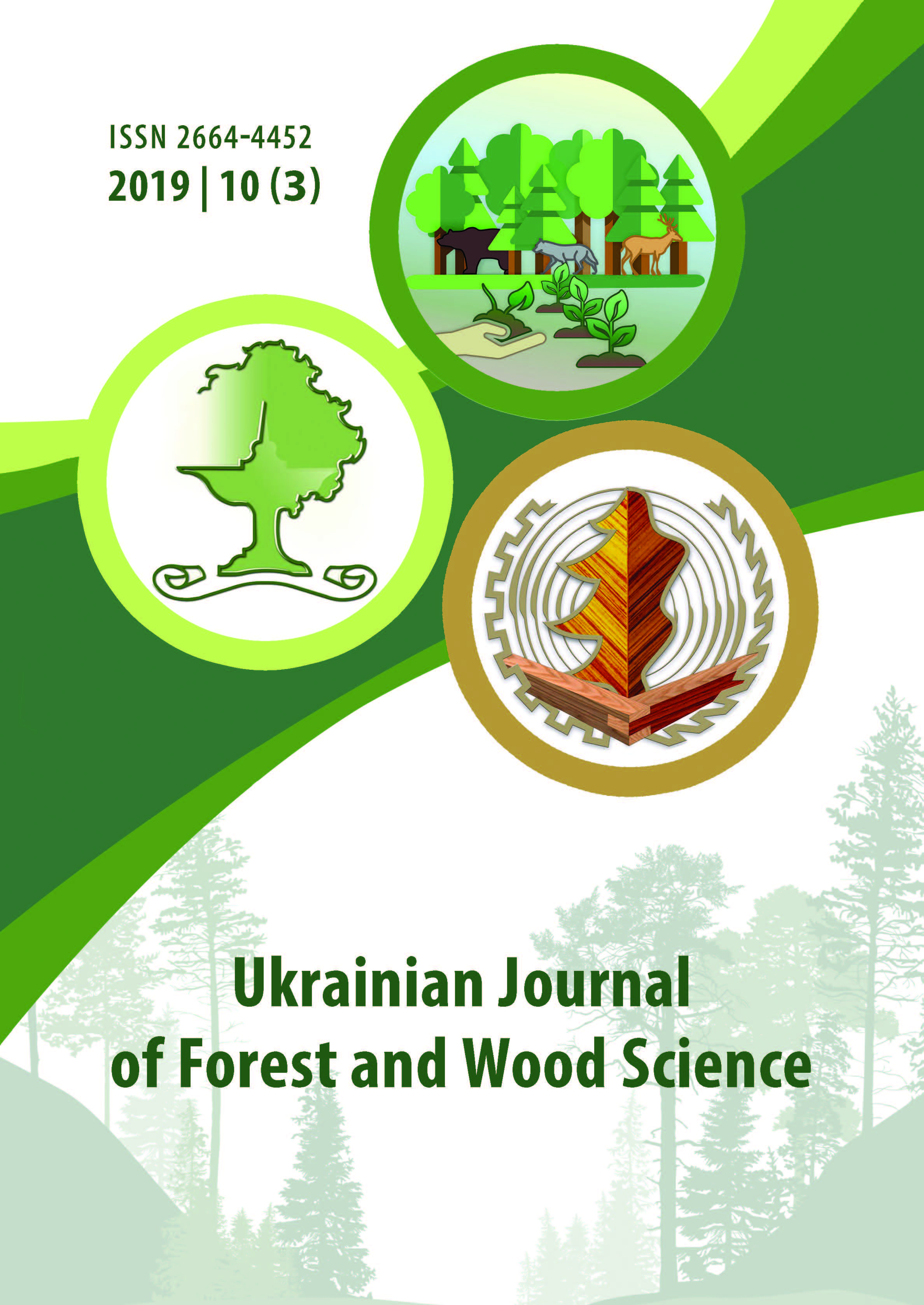The accuracy of measuring the height of trees with the use of a quadrocopter
DOI:
https://doi.org/10.31548/forest2019.03.019Abstract
The issue of improving the accuracy of measuring the height of trees and shrubs is characterized by relevance and practical importance for forestry and landscape gardening due to the influence on the determination of the volume of individual trees and the growing stock. Such measuring is important for landscape and architectural planning and inventory of trees.
The purpose of the study was to check the accuracy of measuring the height of trees using a quadrocopter by comparing these results with their true values (measurements of the length of felled trees). In addition, the heights were determined using the Anuchin’s optical hypsometer and a tree caliper. The UAV DJI Phantom 4 was used for measuring the heights. It was originally placed at the root collar of a growing tree to fix the “zero” point and taken off by the operator in 90˚ shooting mode to the highest point of the tree for calculating the height with GPS-receiver drone instruments. By this way, the information about coordinates and height of the top of the tree as attributes of each photo is stored in digital form.
The proposed approach to measuring the height of trees and shrubs using UAV, was developed to create a method that would offset the existing altimeters main disadvantages: the need to mark the base distance, increase the convenience and accuracy of aiming to the top of the tree, eliminate the influence of the terrain and the curvature of the tree on the measurement results and also provide better accuracy of measurements.
Checking the accuracy of this measurement process showed relative error of measurement < 1 % and better informational content compared to other methods. The main disadvantages of this method are the complexity of its implementation in conditions of dense stands and high requirement to the qualification of the operator.
Such an approach can be used for the forests mensuration needs, for establishing the height classes, inventory of green spaces, creating a database of measurements (with a photographic images of the tops of plants) as well as for other scientific research.
Keywords: hypsometer, tree height determination method, unmanned aerial vehicle, Phantom 4.
References
Anuchin, N. P. (1982). Forest taxation. Moskow: Forest industry, 552 [in Russian].
Artemev, O. S., Vais, A. A., & Naidenko, E. A. (2013). Methods of the heights measuring of trees on the materials of a digital terraneous photographing. Bulletin of the Krasnoyarsk State Agrarian University, 8, 122-125 [in Russian].
Baginskii, V. F. (2013). Forest Taxation: Tutorial. Gomel: GGU im. F. Skoriny [in Russian].
Bidolakh, D. I., Bilous, A. M., & Kuzovych, V. S. (2018). Measurement of the tree and shrub height with the help of unmanned aerial vehicles. Scientific Herald NLTU Ukrainy, 28 (1), 24-27 [in Ukrainian]. https://doi.org/10.15421/40280104
Bidolakh, D. I., Kuzovych, V. S., & Bilous, A. M. (2017). A method of measuring the height of trees and shrubs. Patent UA, no. 12520 [in Ukrainian].
Degerickx, J., Hermy, M., & Somers, B. (2017). Mapping functional urban green types using hyperspectral remote sensing. 2017 Joint Urban Remote Sensing Event (JURSE). https://doi.org/10.1109/JURSE.2017.7924553
Dimitrios Panagiotidis, Azadeh Abdollahnejad, Peter Surový & Vasco Chiteculo. (2017). Determining tree height and crown diameter from high-resolution UAV imagery. International Journal of Remote Sensing, 38 (8-10), 2392-2410. https://doi.org/10.1080/01431161.2016.1264028
Don, C. Bragg. (2014). Accurately Measuring the Height of (Real) Forest Trees. Journal of Forestry, 112 (1), 51-54. https://doi.org/10.5849/jof.13-065
Holiaka, D. M., Kato, H., Yoschenko, V. I., et al. (2018). Identification and estimation of heights of scots pine trees in forest stands in the Chernobyl exclusion zone using stereophotogrammetry method. Scientific Bulletin of UNFU, 28 (10), 18-21. https://doi.org/10.15421/40281003
Markham, D. (2017). This startup will use drones to map forests and plant trees at 1/10th of the usual cost. Retrieved from https://www.treehugger.com/clean-technology/startup-using-drones-plant-trees-110th-usual-cost.html.
Shevelina, I. V., & Korostelev, I. F. (2006). The using of digital cameras for taxing growing trees. The forests of the Urals and the economy in them: Sat Scientific Tr. Federal Agency for Education, Ural State Forestry University, 27, 277-281 [in Russian].
Williams, M. S., Bechtold, W. A., & LaBau, V. J. (1994). Five Instruments for Measuring Tree Height: An Evaluation. Retrieved from https://www.srs.fs.usda.gov/pubs/ja/ja_williams009.pdf.
Zagreev, V. V., Gusev, N. N., Moshkalev, A. G., & Selimov, S. A. (1991). Forest taxation and forest inventory: Tutorial. Moscow: Ecology [in Russian].
Downloads
Published
Issue
Section
License
Relationship between right holders and users shall be governed by the terms of the license Creative Commons Attribution – non-commercial – Distribution On Same Conditions 4.0 international (CC BY-NC-SA 4.0):https://creativecommons.org/licenses/by-nc-sa/4.0/deed.uk
Authors who publish with this journal agree to the following terms:
- Authors retain copyright and grant the journal right of first publication with the work simultaneously licensed under a Creative Commons Attribution License that allows others to share the work with an acknowledgement of the work's authorship and initial publication in this journal.
- Authors are able to enter into separate, additional contractual arrangements for the non-exclusive distribution of the journal's published version of the work (e.g., post it to an institutional repository or publish it in a book), with an acknowledgement of its initial publication in this journal.
- Authors are permitted and encouraged to post their work online (e.g., in institutional repositories or on their website) prior to and during the submission process, as it can lead to productive exchanges, as well as earlier and greater citation of published work (See The Effect of Open Access).

